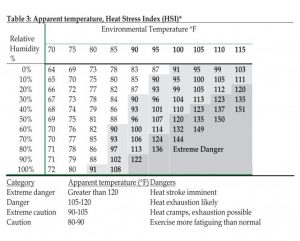- Homepage
- About
- Policies and Guidelines
- Heat Stress Policy
Heat Stress Policy
- Vaccination Policy for Research Personnel
- Trenching and Excavation Policy
- Tractor & Roll Over Protection Structures (ROPS) Safety Policy
- Temporary Structures on Campus (Including Tents)
- Student Shop Safety Policy
- Shop Safety & Machine Guarding Policy
- Respiratory Protection Policy
- Recreational Use of the Lake Alice Watershed Policy
- Q Fever/Coxiella burnetii in Sheep, Goats and Cattle Control Policy
- Powered Industrial Trucks (Forklifts)
- Portable Power Tool Safety
- Personal Protective Equipment
- Occupational Safety Forms
- Natural Gas Leaks Policy
- Motorcycle, Scooter (Includes E-Scooters)/Moped, Segway and Bicycle Use by Employees: Personal Protective Equipment Policy
- Minors in Research Laboratories, Clinics, or Animal Facilities
- Mercury Spills
- Lead Paint Policy
- Lab Closeout Policy
- Indoor Environmental Quality Policy
- Hot Work Safety Policy
- Heat Stress Policy
- Hearing Conservation Policy
- Hazardous Energy Control (Lock out/Tag out) Policy
- Hazard Communication Policy
- Golf Cart Policy
- Feral Cats & Other Wild Animals Living on Campus Policy
- Fall Protection Policy
- Electronics Reuse/Recycle
- Drones & Unmanned Aircraft System Policy
- Dive Boat Safety Policy – Responsibilities
- Contractor Health and Safety Requirement Policy
- Confined Space Entry Policy
- Compressed Gas Cylinders Use and Storage
- Compressed Gas Cylinders Condensed Safety Rules
- Chain Saw Safety Policy
- Building Code Enforcement Policy
- Biological Waste Disposal Policy
- Bicycles and Other Transportation Vehicles in University Buildings
- Basic Electrical Safety Policy
- Asbestos Policy
- Asbestos Floor Tile Policy
- 3D Printer Policy
- 12 & 15 Passenger Van Policy
- Service Animals in Labs
- UF EH&S Policy
- Environmental Health & Safety Policy
OBJECTIVE
The objective of this policy is to reduce the risk of illness, injury or fatality to UF employees, students, volunteers and contractors under direct UF supervision from heat related disorders.
POLICY
This policy impacts all employees, students, volunteers, and contractors (working under direct UF supervision), who work in hot environments.
AUTHORITY
By authority delegated from the University President, the Vice-President for Business Affairs is responsible for the safety of all University facilities. Under this authority, policies are developed to provide a safe teaching, research, service, housing and recreational environment.
RESPONSIBILITIES
Heat Stress Prevention Program
Many workers at the University work in hot environments. These include employees working at physical plant, housing, hazardous waste, pest control, fine arts, laundry and agricultural worksites. Working in hot conditions poses many safety and health hazards to the workers. This policy addresses ways to minimize and control these hazards.
Four environmental factors affect the amount of stress a worker experiences in a hot environment: temperature, humidity, air velocity and radiant heat. Examples of radiant heat include direct heat from the sun or a furnace. Job-related factors that affect heat stress include work rate and physical effort required, type of clothing and protective equipment used, and duration of activity. All of these factors need to be evaluated in order to minimize their impact on the worker. Personal characteristics such as age, weight, physical fitness, and acclimatization to the heat also need to be factored in to determine those people and areas at high risk.



